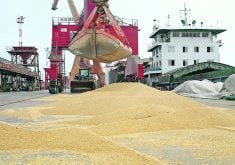Canadians feel pinch | A poor pulse crop may force the country to resume imports
Asia’s worst performing currency has hurt Canadian pulse sales, says a grain market analyst.
The Indian rupee fell 20 percent compared to the U.S. dollar between Aug. 1 and the middle of December. It has recovered slightly, but is still well below where it was in the summer.
The rupee’s slide has caused serious problems for India’s pulse importers, who are paying almost 20 percent more for product that they signed contracts for months ago.
“Pulses importers have not burnt their fingers, they have burnt their bodies this year,” Bimal Kothari, vice-president of India Pulses and Grains Association, said in a Dec. 29 article published in the Business Standard, India’s leading business daily.
Read Also

Defence investments could benefit agriculture
A bump in Canada’s NATO spending commitments could lead to infrastructure investments that would benefit rural areas
Losses are expected to exceed $97 million, and the devalued rupee is forcing importers to stop importing.
“The landed price of pulses at the current rupee exchange rate and international prices will be significantly higher than the prevailing domestic prices,” said Kothari.
He said import prices need to fall more to offset the rupee’s depreciation.
Chuck Penner, market analyst with LeftField Commodity Research in Winnipeg, said the devaluation of the rupee has already been reflected in prices.
“It is probably one of the key price drivers over the last two to three months, so it is an important factor but it’s mostly in there already.”
Bulk yellow peas that were selling for $415 US per tonne in Vancouver in September are now $380 per tonne.
Penner said there has been little business with India, even with sharply lower pea and lentil prices.
In fact, there were rumours last month that Indian importers backed out of pulse contracts with Australian exporters.
“(The rupee) has certainly had an impact. No question about it,” he said.
Fortunately, China has been buying a lot of Canadian peas, and looming supply problems in India may reignite sales.
The summer pulse crop was disappointing and the winter crop may also be in trouble.
India’s agriculture ministry reports that growers had planted 34.7 million acres of pulses as of Jan. 6, down 1.2 percent from the pace of last year’s record winter plantings. Chickpeas are six percent behind last year’s pace at 21.5 million acres.
Penner said this comparison is a little deceiving because some of India’s states can be late filing data. Growers are just 0.6 percent off last year’s record pace when comparing the ministry’s Jan. 6, 2012, seeding report to the one filed Jan. 7, 2011.
However, Penner believes the winter crop could be in trouble. The northern two-thirds of the country, where most of the pulses are grown, has received little rain since the end of the monsoon.
“It has been very, very dry since October. Some of those areas have had almost no rain,” he said.
“That is something to really, really be watched and that’s going to add a lot of uncertainty to that market.”
Canadian growers should also be aware that while total winter plantings are similar to last year, there are important differences. Pea acres are up, but lentil and chickpea plantings are down.
















